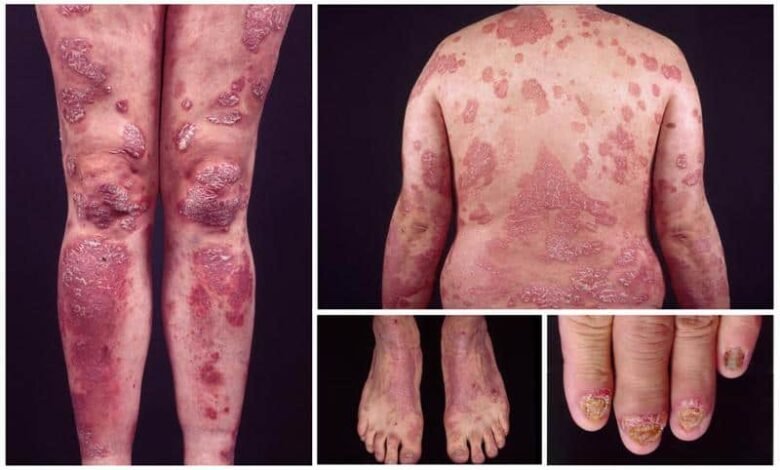Psoriasis

What is psoriasis?
Psoriasis is a complex, chronic, multifactorial, inflammatory disease that consists of hyperproliferation of keratinocides in the epidermis combined with abnormally rapid growth of epidermal cells.
The disease most often appears on the skin of the elbows, knees, hairy part of the head, but it is possible to appear on other areas of the skin. In approximately 30% of diseased joints are also affected.
Symptoms of Psoriasis
Placardum psoriasis is the most common form and causes:
- Appearance of plaques on the skin, which can vary in size and can be limited to certain areas or be quite large. The shape of the plaques is usually round with irregular borders. Smaller areas where the plaques are located can merge with other skin areas with plaque and thus form larger areas with psoriatic plaque. The skin in these areas is scaly.
- The plaques may itch or burn.
- In areas with psoriatic plaques, the skin may to crack and especially on the joints to start bleeding.
Although plaque psoriasis is the most common form, there are other types that can appear on different parts from the body.
Erythrodermic psoriasis
This type of psoriasis covers the whole body and causes intense red plaques that cover a large part of the skin.
This is a very serious condition that can lead to serious complications such as sweating, variations in body temperature and disturbances in the body’s hydration.
Inverse psoriasis
This type mainly affects the storage areas of the body, such as the armpits, under the breasts, inguinal area and around the anus.
Plaques are usually smooth and red, without scaling. This type of psoriasis can be reversed by irritation or sweating of the affected skin.
Pumpy psoriasis
Pull-shaped psoriasis is characterized by the appearance of small, tear-shaped plaques on the body, which are usually associated with infections, stress or trauma.
This type of psoriasis can be irritating and itchy, especially when plaques form on sensitive areas such as the face, scalp and genitals.
Pustulous psoriasis
This type is rare and is characterized by the formation of pustules – small nodules filled with pus that usually affect the hands and feet. This is a serious condition that requires urgent treatment.
Psoriasis in children – the pro-psoriatic plaque looks a little different compared to that in adults. In children, the plaque is not as thick and less scaly and can often appear in the diaper area and on the elbows.
Causes of Psoriasis
The cause of psoriasis is not fully understood, but it is believed to be related to problems with immune system cells. Specifically, a type of cell called T-lymphocytes or T-cells.
T cells normally travel around the body to detect and fight foreign substances that enter the body such as bacteria and viruses.
In psoriasis, however, T cells attack healthy skin cells by mistake, as if to heal the wound or fight infection.
This leads to an increase in the production of healthy skin cells and more T-cells and other white blood cells.
Treatment of psoriasis
- Exposure to sunlight helps most people with psoriasis
- Keeping the skin soft and moist is also helpful for this condition. Apply strong moisturizing creams after bathing.
- Do not use cosmetics or soaps that irritate your skin.
- Avoid scratching the affected areas. This can lead to bleeding or excessive irritation.
- Cortisone creams can reduce itching and are available without a prescription.
There are three ways to treat psoriasis:
- Standard therapy – medications applied externally as creams, ointments and gels.
- Phototherapy (light therapy)
- Systemic therapy (regular intake of drugs in the form of tablets)
These methods of treatment can be administered alone or in combination.
There is a way of treatment that is not accepted by official medicine, but it gives excellent results and does not require a visit to doctors, taking medication, etc.
All you need to do is start keeping a diary and write down daily what you ate during the day.
And once you’ve gathered enough information about what you’ve been eating, you’re required to start cutting out one of the foods you regularly eat for about a week.
You should observe how this shutdown has affected your skin and if it has affected the condition.
And so until you notice that the absence of a certain food from your menu has a positive effect on the condition of your skin.
Your goal in this case will be to completely eliminate the food that is causing your psoriasis.
Psoriasis Prevention
Psoriasis prevention is important and can help affected individuals control the onset and worsening of symptoms.
Although the reasons for the development of psoriasis are not completely clear, certain factors and lifestyle changes can help reduce the risks of the disease.
Here are some additional tips for psoriasis prevention:
-
Healthy Diet: Eating a balanced and healthy diet is important for strengthening the immune system and overall skin health. Include fruits, vegetables, whole grains and oily fish, which contain beneficial unsaturated fatty acids.
-
Stress Management: Emotional stress has been linked to psoriasis flare-ups in many affected people. Practices such as yoga, meditation, aromatherapy, and relaxation techniques can help manage stress and improve general well-being.
-
Maintaining an optimal weight: Some studies show that being overweight can increase the risk of developing psoriasis. If you’re overweight, talk to your doctor about building a healthy weight loss plan that combines a balanced diet and regular exercise.
-
Avoid smoking: Nicotine and other harmful substances in tobacco can increase the risk of psoriasis and affect the severity of symptoms. If you smoke, consider options to stop this harmful habit.



